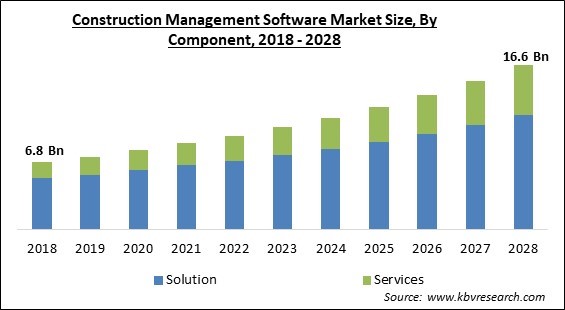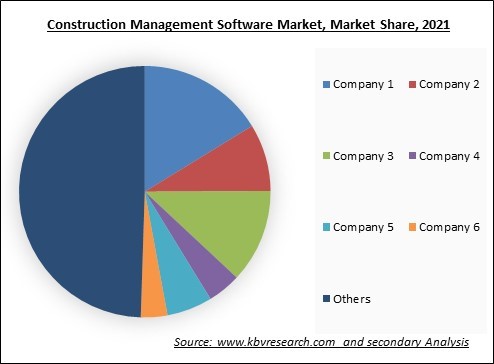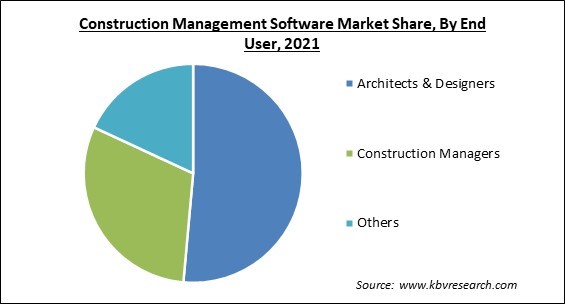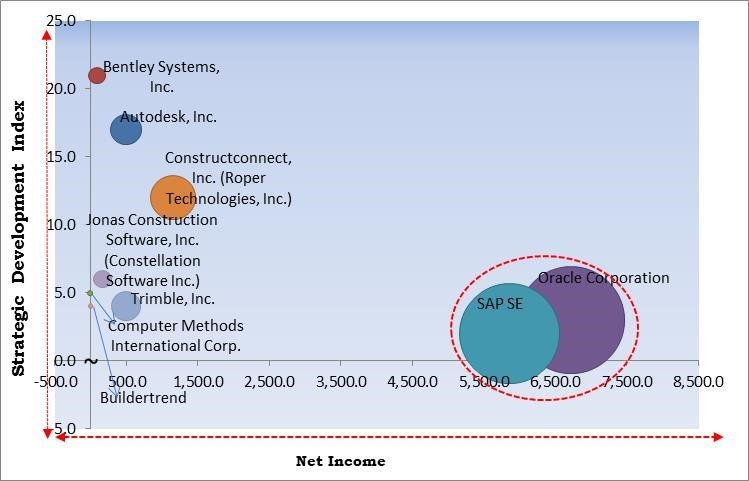The Global Construction Management Software Market size is expected to reach $16.6 billion by 2028, rising at a market growth of 9.8% CAGR during the forecast period.
Construction management software is a project management platform that assists organizations with processes like communication, budget management, job scheduling, and decision-making. Its objective is to make construction processes easier through automation. It is a project management tool designed mainly for construction professionals.

This kind of software offers a range of benefits to construction industry members, easing up the processes that were earlier done manually. Companies are known to have a lot of benefits from utilizing construction management software. Construction management software aids in project scheduling and planning in the construction industry.
This is done by sequencing operations of the construction project and enabling effective usage of the schedules made through a work breakdown structure. The features and functions of construction software management include specifying a project’s target and plans, including delineation of scope, scheduling, budgeting, setting performance requirements, and selecting project participants.
The construction management software assists in monitoring the cost-control system to get an estimated project profit and to monitor the predicted results. Construction project management software gives features to manage construction projects starting from their inception by enabling components that monitor numerous project stages, including procurement of contract methods, design service & contractors, and management of the construction contract process.
COVID-19 has forced governments of various nations to impose lockdowns to stop the spread of the disease, significantly affecting the construction management software market. With the government restriction, construction work was halted, further affecting the market growth in the short run. COVID-19 caused a slight degeneration in the market development because of the termination of the functions of several construction places. However, due to the pandemic, numerous construction companies started to take virtual tours of the spaces for construction. This aided the stakeholders and investors in the construction sector to have a good view of the project for their interest which favored the growth of the construction management software market.

The leading players in the market are competing with diverse innovative offerings to remain competitive in the market. The below illustration shows the percentage of revenue shared by some of the leading companies in the market. The leading players of the market are adopting various strategies in order to cater demand coming from the different industries. The key developmental strategies in the market are Acquisitions.
The pandemic caused a considerable number of routine activities and businesses to shift their operations online and made it challenging to work on a building site. The construction industry is collaborative and requires quality and manufacturing control and proper understanding between the various stakeholders engaged in the project. A construction project generally contains various components, including vendors, architects, contractors, engineers, and the workforce. For many years, tablets, drawings, and graphs were utilized to record the information exchange between the involved parties. These factors are expected to boost the construction management software market’s growth.
The oil and gas industry are observing a prominent surge in demand for cloud-based construction management software. This is since these software assists in raising visibility and transparency in brownfield, onshore, and shale-based construction activities. The software is also beneficial in tracking the development of oil & gas units and tracking oil & gas activities in deepwater. Hence, the constant increase in the adoption of cloud-based solutions especially in the oil & gas industry is expected to drive the growth of the construction management software market in the projected period.
This factor would be a barrier to the adoption of construction management software. Furthermore, construction software is known to be complex to handle and manage, discouraging numerous organizations from adopting this software. Furthermore, the pandemic has impacted the construction and infrastructure sectors and offered a more comprehensive range of challenges to the industry. There is also uncertainty about recovery from the pandemic, which has caused a decrease in investment in this technology. The high cost and hardship faced during the software are anticipated to hamper its adoption, thereby restricting the market growth.
Based on component, the construction management software market is segmented into solution and services. In 2021, the solution segment dominated the construction management software market with the maximum revenue share. The growth is attributed to the high requirement for construction software to enhance construction workloads. This software provides a secure platform that allows users to manage project plans, budgets, phases, risks, and schedules. Also, it provides a collaborative atmosphere that simplifies coordination and communication, aligning all teams’ goals to a shared vision. The mentioned benefits will surge the growth of the segment.

On the basis of deployment mode, the construction management software market is divided into on-premises and cloud. The on-premise segment witnessed the largest revenue share in the construction management software market in 2021. The growth is attributed to the control and flexibility offered by the on-premise deployment to customize the organization's system software and IT infrastructure and manage data. Also, on-premise servers provide construction firms with an internal network that is accessible at any time without the requirement of a proper internet connection. The control and flexibility joined with other benefits, will drive the segment's growth in the forecasted period.
By building type, the construction management software market is classified into commercial building and residential building. In 2021, the commercial segment recorded a significant revenue share in the construction management software market in 2021. This is because of the rising usage of construction management software for commercial building construction. Also, the rising focus on sustainable development is increasing the preference for green commercial buildings among occupiers and developers both. Hence, the wider utilization of construction-based software and the increasing commercial buildings sector will drive the segment’s growth.
Based on the end user, the construction management software market is bifurcated into architects & designers, construction managers and others. The construction manager segment acquired a remarkable growth rate in the construction management software market in 2021. This is because this software integrates costing, enterprise, and project accounting for live analysis and effective project management. Web-based enterprise management system gives industry-aligned information to construction companies. Construction managers utilize this software to drive efficiency in construction projects through close coordination of the numerous stakeholders involved in the project. Thereby, these characteristics are anticipated to boost the segment’s expansion.
By application, the construction management software market is classified into project management & scheduling, safety & reporting, project design, field service management, cost accounting and others. The project management & scheduling segment generated the highest revenue share in the construction management software market in 2021. This is due to the increasing requirement to control and manage project activities like allocating resources, tracking project progress, and reducing time delays. Such solutions allow the organization to gain momentum and traction to meet the project objectives within the given time frame. Hence, these features will drive market growth.
| Report Attribute | Details |
|---|---|
| Market size value in 2021 | USD 8.7 Billion |
| Market size forecast in 2028 | USD 16.6 Billion |
| Base Year | 2021 |
| Historical Period | 2018 to 2020 |
| Forecast Period | 2022 to 2028 |
| Revenue Growth Rate | CAGR of 9.8% from 2022 to 2028 |
| Number of Pages | 328 |
| Number of Table | 533 |
| Report coverage | Market Trends, Revenue Estimation and Forecast, Segmentation Analysis, Regional and Country Breakdown, Market Share Analysis, Competitive Landscape, Companies Strategic Developments, Company Profiling |
| Segments covered | Component, Deployment Mode, Building Type, Application, End User, Region |
| Country scope | US, Canada, Mexico, Germany, UK, France, Russia, Spain, Italy, China, Japan, India, South Korea, Singapore, Malaysia, Brazil, Argentina, UAE, Saudi Arabia, South Africa, Nigeria |
| Growth Drivers |
|
| Restraints |
|
Region-wise, the construction management software market is analyzed across North America, Europe, Asia Pacific, and LAMEA. The North America region held the highest revenue share in the construction management software market in 2021. The growth is attributed to the rising awareness and the government’s focus on using construction management software. There is a large-scale adoption of digital systems in the infrastructure domain and BIM by engineers, builders, architects, and builders. Hence, the role of the government to increase the software’s utilization due to its higher quality of construction projects joined with digitalization will surge the market growth in the region.
Free Valuable Insights: Global Construction Management Software Market size to reach USD 16.6 Billion by 2028

The major strategies followed by the market participants are Product Launches. Based on the Analysis presented in the Cardinal matrix; SAP SE and Oracle Corporation are the forerunners in the Construction Management Software Market. Companies such as Bentley Systems, Inc., Autodesk, Inc., and Constructconnect, Inc. (Roper Technologies, Inc.), are some of the key innovators in Construction Management Software Market.
The market research report covers the analysis of key stake holders of the market. Key companies profiled in the report include Oracle Corporation, SAP SE, Autodesk, Inc., Bentley Systems, Inc., Trimble, Inc., Constructconnect, Inc. (Roper Technologies, Inc.), Jonas Construction Software, Inc. (Constellation Software Inc.), Buildertrend, Computer Methods International Corp., and Odoo SA.
By Component
By End User
By Deployment Mode
By Building Type
By Application
By Geography
The global Construction Management Software Market size is expected to reach $16.6 billion by 2028.
The requirement to enhance the construction productivity are driving the market in coming years, however, High cost and hampered adoption due to pandemic restraints the growth of the market.
Oracle Corporation, SAP SE, Autodesk, Inc., Bentley Systems, Inc., Trimble, Inc., Constructconnect, Inc. (Roper Technologies, Inc.), Jonas Construction Software, Inc. (Constellation Software Inc.), Buildertrend, Computer Methods International Corp., and Odoo SA.
The Architects & Designers segment acquired maximum revenue share in the Global Construction Management Software Market by End User in 2021 thereby, achieving a market value of $8.3 billion by 2028.
The Residential Building segment is leading the Global Construction Management Software Market by Building Type in 2021 thereby, achieving a market value of $10.8 billion by 2028.
The North America market dominated the Global Construction Management Software Market by Region in 2021, and would continue to be a dominant market till 2028; thereby, achieving a market value of $5.5 billion by 2028.
Our team of dedicated experts can provide you with attractive expansion opportunities for your business.

